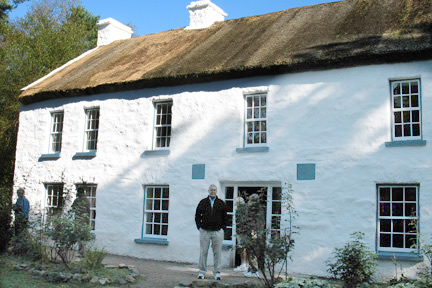
| Home | Family History |
Ancestry Chart |
DNA Results |
Ireland 2009 |
Family Photos |
Memories of Ireland - A visit to the origins of the McMullen family
September 2009
The climate is cool, especially after coming from Arizona. It never goes much above 60 degrees. I was sure I would be too warm, and included several short sleeved shirts in my luggage. But I wore long-sleeved turtle necked shirts while we were there.
 It rains often, accounting for the very green fields and trees. We were fortunate and had sunny weather except for one rainy day and one cooler day.
It rains often, accounting for the very green fields and trees. We were fortunate and had sunny weather except for one rainy day and one cooler day.
The soil is rocky, accounting for miles and miles of stone fences (probably hundreds and hundreds of years old) in the fields. They were constructed without gates, the farmer simply pulling down the wall when necessary, and then rebuilding it. We did see several walls that had modern gates installed.
Sheep and cattle are the main industry. Hay is cut for the cattle and then mixed with molasses and baled for winter use. The hay is not left to dry because of the frequent rain. Corn is also planted as silage for the cattle. It never matures to the point where the stalks form ears, but is merely cut in the fall and stored for winter use.
Sheep production has been subsidized by the Ireland government, but that is to end next year. It is expected sheep production will then drop substantially due to the low demand for wool. Apparently wool has been replaced by fabrics what do not require dry cleaning and are easier to care for.
We were amazed to learn residents are still cutting and burning peat for heating and cooking. This occurs in the rural areas. Gas and oil are available in the cities. We saw large piles of peat cut and left to dry, and in other places piles of peat covered with plastic to keep it dry.
The housing we saw along the main roads was modern and very well kept. Perhaps there were thatched cottages on secondary roads, but we did not see any. We were told there was an over abundance of housing, just as in the U.S., a result of the building boom.
The best area for growing vegetables and other crops was south of Dublin–the soil there is better. Other areas yield a poor crop.
The monistaries we visited dated back several hundred years. Walls and fortifications built in Waterford and Londonderry are also ancient, but still standing. This is also true of many churches across the country.
 The highlight of the trip, in my opinion, was our visit to the Ulster American Folk Park at County Tyrone. Established by Thomas Mellen, founder of the Mellen Bank in New York, and located on the Mellen property, it depicts typical housing in Ireland about 1800, the voyage to the U.S. and early housing in Pennsylvania. A small museum indoors documents the lives of immigrants to the U.S.
The highlight of the trip, in my opinion, was our visit to the Ulster American Folk Park at County Tyrone. Established by Thomas Mellen, founder of the Mellen Bank in New York, and located on the Mellen property, it depicts typical housing in Ireland about 1800, the voyage to the U.S. and early housing in Pennsylvania. A small museum indoors documents the lives of immigrants to the U.S.
Eleanor McMullen Blumenschein